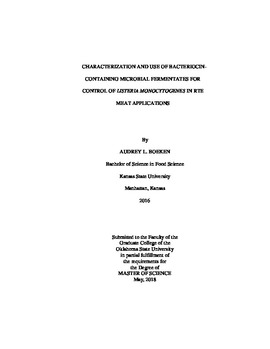| dc.contributor.advisor | Muriana, Peter M. | |
| dc.contributor.author | Boeken, Audrey Lynn | |
| dc.date.accessioned | 2019-03-29T15:39:48Z | |
| dc.date.available | 2019-03-29T15:39:48Z | |
| dc.date.issued | 2018-05-01 | |
| dc.identifier.uri | https://hdl.handle.net/11244/317792 | |
| dc.description.abstract | Bacteriocins produced by lactic acid bacteria (LAB) are able to inhibit the growth of Listeria monocytogenes, and because of their GRAS (generally recognized as safe) status, they have become subjects of interest for use as additives in foods as an antimicrobial. | |
| dc.description.abstract | Bacteriocins work by different modes of action (MOA). By screening bacteriocins based on mode of action against Listeria monocytogenes, a multiple MOA bacteriocin cocktail can be created for use as a "hurdle" technology to inhibit the growth of Listeria, as well as prevent the outgrowth of spontaneously-resistant listerial strains. | |
| dc.description.abstract | We developed a series of Listeria strains resistant to three different MOA and screened animal-sourced samples for bacteriocins displaying a unique fourth MOA. From this procedure, two unique bacteriocin-producing bacteria were isolated and identified using 16s PCR. Cell-free supernatant (CFS) containing bacteriocin from one of these isolates, Streptococcus spp. 323 was purified using ammonium sulfate precipitation, C18 sep-pack elution, and elution from reverse-phase HPLC with an acetonitrile gradient. Purified sample was submitted to the Oklahoma State University Core Facility for analysis by mass spectrometry. | |
| dc.description.abstract | Certain bacteriocin-producing cultures have been implicated as opportunistic pathogens and thus merits analysis of these strains for virulence factors prior to application of CFS in foods. Streptococcal and enterococcal strains were analyzed for hemolysin and gelatinase production, with only one strain producing hemolysin and four displaying gelatinase production. Results assisted in the development of a bacteriocin cocktail utilizing 3 MOA for use in hotdog applications. | |
| dc.description.abstract | Frankfurters were formulated with different antimicrobial treatments (bacteriocin cocktail applications, NovaGard, Durafresh 2016) and underwent a series of shelf-life studies. Studies showed antimicrobials tested had a significant decrease in L. monocytogenes from control hotdog batches. Most notably, the use of bacteriocin cocktails within the meat matrix provided a nearly 7-log reduction 16 weeks after inoculation with L. monocytogenes. | |
| dc.description.abstract | Given the results of this study, the use of multiple MOA bacteriocin cocktails significantly reduce L. monocytogenes in hotdogs and can be used as an effective antimicrobial intervention in foods. | |
| dc.format | application/pdf | |
| dc.language | en_US | |
| dc.rights | Copyright is held by the author who has granted the Oklahoma State University Library the non-exclusive right to share this material in its institutional repository. Contact Digital Library Services at lib-dls@okstate.edu or 405-744-9161 for the permission policy on the use, reproduction or distribution of this material. | |
| dc.title | Characterization and Use of Bacteriocin-Containing Microbial Fermentates for Control of Listeria Monocytogenes in RTE Meat Applications | |
| dc.contributor.committeeMember | Jadeja, Ravirajsinh P. | |
| dc.contributor.committeeMember | McGlynn, William G. | |
| osu.filename | Boeken_okstate_0664M_15711.pdf | |
| osu.accesstype | Open Access | |
| dc.description.department | Food Science | |
| dc.type.genre | Thesis | |
| dc.type.material | text | |
